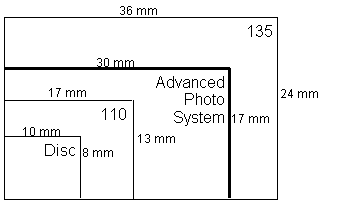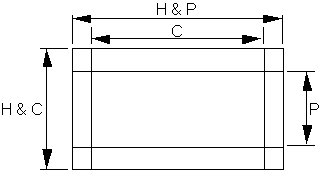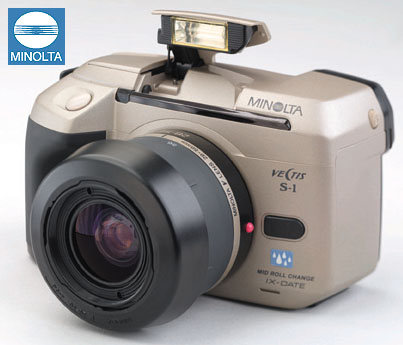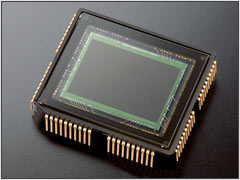Digital Photography from 20,000 Feet
by Wesley Fink on September 25, 2006 12:05 AM EST- Posted in
- Digital Camera
The Digital SLR
Several factors delayed the move to SLR technology for digital photography. First, the early sensors were much lower megapixel resolutions, far too low to begin to compete with film photography. Photo hobbyists saw few advantages to moving to a low resolution system since the reason they used an SLR was high image quality. It wasn't until resolutions reached the 2 to 4 megapixel range that there was any interest in a digital SLR.
Second, the early sensors were very small, developed primarily for video usage. Some tried to develop proprietary systems based on a smaller sensor size with more compact lenses, but nothing caught on in the industry. The cost of early sensors was also astronomical, making the early digital SLR cameras only useful for production, high volume photography where the cost could be justified.
Third, with sensor resolution and size in constant development it was much easier to design a point-and-shoot camera around each new sensor generation. Until sensor size stabilized, a digital SLR that used existing lens systems was not practical.
APS (Advanced Photo System)
35mm first appeared on the scene in the 1930s and the film format simply took 35mm motion picture film and spooled it into a light-tight canister. By the 1960s, with point-and-shoot and developments in SLR technology, 35mm had become king of the film formats. Even as film manufacturers tried to introduce other film formats, 35mm continued to grow and prosper. With the very early developments in digital photography, Kodak, Fuji and others saw the handwriting on the wall for film photography. One of the ongoing complaints about 35mm film, however, has been that the 2:3 image format required image loss in almost every standard print size. 8x10 and 5x7 are neither a 2:3 ratio and both required cropping of the 35mm negative.

In 1996 a new APS (Advanced Photo System) initiative by Kodak, Fujifilm, Minolta, Nikon, Canon and others was introduced to save film by standardizing on new ratios and adding new "computer-like" data storage capabilities in the taking and processing of images. APS included a new film size - 30.2mm x 16.7mm - that could be printed full-frame (H or HDTV format), or use standard crops of 25.1mm x 16.7mm (C or Classic 2:3 format) or 9.5mm x 30.2mm (P or Panorama). Actually, the image size that was always shot was the 30.2mm x 16.7mm, and the other sizes were just standard crops.

The industry was confident they could sell APS, which in the most common C view was only about 55% of the already small 35mm size. Some manufacturers like Minolta developed new APS lens lines with smaller cameras and lenses, and Canon and Nikon developed APS camera bodies that could mount their regular lenses - and a few custom APS lenses.

In the end, APS failed in the film market, but it is important in our discussion of Digital Photography because it was also a standard for digital development. At the time of the APS initiatives, it seemed reasonable to aim for development of digital sensors for that same APS format, so lenses for both systems were interchangeable. The industry aimed for the APS C size sensor, which would be about 16.7mm x 25.1mm the same ratio (2:3) as the classic 35mm format. This allowed existing 35mm lenses to be used, with a lens factor of 1.5 to 1.6, and the development of new lenses with a smaller image circle.
What do we mean by Lens Factor? Why does it matter?
The Lens Factor
APS really doesn't matter in the film market, except as a brief and intense flurry of activity that has produced a huge number of APS cameras in every imaginable format. Some of the high-end models are particularly interesting and will become collectibles. APS cameras like the tiny Minolta Vectis S-1 SLR system, the Canon IX, and Nikon Pronea are remarkably well-built and intelligent designs for the APS format.

The APS may be discontinued and dying in the film market, but it is alive and well in today's Digital SLR market. Today Sony, Nikon, Canon, Pentax, Minolta, Samsung and every other production SLR on the market (except Olympus) uses a sensor that is approximately APS C size. This matters because the lenses designed for 35mm SLR photography do not behave the same when used to capture images with the smaller APS sensor.
Several factors delayed the move to SLR technology for digital photography. First, the early sensors were much lower megapixel resolutions, far too low to begin to compete with film photography. Photo hobbyists saw few advantages to moving to a low resolution system since the reason they used an SLR was high image quality. It wasn't until resolutions reached the 2 to 4 megapixel range that there was any interest in a digital SLR.
Second, the early sensors were very small, developed primarily for video usage. Some tried to develop proprietary systems based on a smaller sensor size with more compact lenses, but nothing caught on in the industry. The cost of early sensors was also astronomical, making the early digital SLR cameras only useful for production, high volume photography where the cost could be justified.
Third, with sensor resolution and size in constant development it was much easier to design a point-and-shoot camera around each new sensor generation. Until sensor size stabilized, a digital SLR that used existing lens systems was not practical.
APS (Advanced Photo System)
35mm first appeared on the scene in the 1930s and the film format simply took 35mm motion picture film and spooled it into a light-tight canister. By the 1960s, with point-and-shoot and developments in SLR technology, 35mm had become king of the film formats. Even as film manufacturers tried to introduce other film formats, 35mm continued to grow and prosper. With the very early developments in digital photography, Kodak, Fuji and others saw the handwriting on the wall for film photography. One of the ongoing complaints about 35mm film, however, has been that the 2:3 image format required image loss in almost every standard print size. 8x10 and 5x7 are neither a 2:3 ratio and both required cropping of the 35mm negative.

In 1996 a new APS (Advanced Photo System) initiative by Kodak, Fujifilm, Minolta, Nikon, Canon and others was introduced to save film by standardizing on new ratios and adding new "computer-like" data storage capabilities in the taking and processing of images. APS included a new film size - 30.2mm x 16.7mm - that could be printed full-frame (H or HDTV format), or use standard crops of 25.1mm x 16.7mm (C or Classic 2:3 format) or 9.5mm x 30.2mm (P or Panorama). Actually, the image size that was always shot was the 30.2mm x 16.7mm, and the other sizes were just standard crops.

The industry was confident they could sell APS, which in the most common C view was only about 55% of the already small 35mm size. Some manufacturers like Minolta developed new APS lens lines with smaller cameras and lenses, and Canon and Nikon developed APS camera bodies that could mount their regular lenses - and a few custom APS lenses.

In the end, APS failed in the film market, but it is important in our discussion of Digital Photography because it was also a standard for digital development. At the time of the APS initiatives, it seemed reasonable to aim for development of digital sensors for that same APS format, so lenses for both systems were interchangeable. The industry aimed for the APS C size sensor, which would be about 16.7mm x 25.1mm the same ratio (2:3) as the classic 35mm format. This allowed existing 35mm lenses to be used, with a lens factor of 1.5 to 1.6, and the development of new lenses with a smaller image circle.
What do we mean by Lens Factor? Why does it matter?
The Lens Factor
APS really doesn't matter in the film market, except as a brief and intense flurry of activity that has produced a huge number of APS cameras in every imaginable format. Some of the high-end models are particularly interesting and will become collectibles. APS cameras like the tiny Minolta Vectis S-1 SLR system, the Canon IX, and Nikon Pronea are remarkably well-built and intelligent designs for the APS format.

The APS may be discontinued and dying in the film market, but it is alive and well in today's Digital SLR market. Today Sony, Nikon, Canon, Pentax, Minolta, Samsung and every other production SLR on the market (except Olympus) uses a sensor that is approximately APS C size. This matters because the lenses designed for 35mm SLR photography do not behave the same when used to capture images with the smaller APS sensor.










81 Comments
View All Comments
wheel - Tuesday, September 26, 2006 - link
Thanks for your reply.Regarding the Canon 50mm 1.8, I think most people would agree that the 1.4 is better since it has full time manual focus and also a silent USM motor, plus 8 aperture blades instead of 5 for nicer, smoother looking bokeh (out of focus areas in an image). Of course when you consider the cost differential most people choose the f1.8 and for many it is the smarter choice! However I still believe your sentence in the article suggesting that it happens to be the sharpest lens in the lineup a little misleading. Not a big deal I guess.
If I can make some comments on the following paragraph:
There are plenty of Digital Camera Review sites out on the web, so you may ask why AnandTech is re-launching a Digital Photography section. It appears that current sites are rarely on target with what computer enthusiasts want to know about digital cameras. Some sites make the assumption that the reader knows a lot more about photography than our average reader, which often leads to much of the review being gibberish to a non-photographer. Other sites dwell on tests of things like "start-up times" that were important in early digital, but have become all but meaningless in today's digital SLR market. Still other sites, which are very well-grounded in traditional photography show an obvious lack of knowledge about computers and computer tools that make digital photography so flexible today. It is our sincere belief that we can do it in a better way for our readers and computer enthusiasts everywhere, but please help us as we try to reinvent this wheel. Some of our readers may not like AT delving into Digital Camera Reviews, and to them we say you just can't ignore digital photography any more. Today's digital imaging is nothing more than an optic stuck on a computer, and there is very little left of the mechanical gems that once ruled the world of photography.
A few points:
"Some sites make the assumption that the reader knows a lot more about photography than our average reader, which often leads to much of the review being gibberish to a non-photographer."
So a 'non-photographer' will find a technical review on the big digital camera sites gibberish? I don't think that is a problem, because such reviews aren't really aimed at non-photographers. I would guess that non-computer users are going to find articles on Anandtech about ram timings difficult to understand too!
Other sites dwell on tests of things like "start-up times" that were important in early digital, but have become all but meaningless in today's digital SLR market.
See my comments re: sports / action photography in my previous post. Start up times, shot to shot times and file flush times are quite important to me! Other sites have (very comprehensive) standardised tests that include these timings. I wouldn't say they dwell on the subject though, unless a particular camera is unusually bad at it. If it is not something that is relevant then a reader can easily skip it.
Still other sites, which are very well-grounded in traditional photography show an obvious lack of knowledge about computers and computer tools that make digital photography so flexible today.
In my years of reading the major photo review websites, I haven't encountered this. Without asking you to be specific, can you mention general examples of what you mean?
Cheers,
Ian
tagej - Tuesday, September 26, 2006 - link
The reality is that most computer geeks (myself included) are not photography experts, but are overall tech-savy and interested in things like digital SLR cameras.Sure, I can go to sites like dpreview and the like, and they do an excellent job of reviewing cameras from a pro or prosumer perspective. I could sit and read a bunch of stuff on those sites and educate myself to the point of becoming very knowledgable about cameras... Most of us don't want to do that, or we would have already done so. Instead, AT hit it right on the head with this article, it's a look at digital photograhpy for the tech savy who are not photography experts.
arswihart - Tuesday, September 26, 2006 - link
I totally agree with "wheel." If you feel the need to review cameras, go ahead, but thats not what I come to Anandtech for.aeternitas - Monday, September 25, 2006 - link
" The artistic types distrust turning their vision into cheap Adobe Photoshop tricks, and the tech-savvy are so enamored of technology and editing that they often don't have a clue about what makes a good photograph and what lens to use in a given situation. "I stopped reading there. If you want respectable people to respect you, its a good idea not to be a fucking jackass and insult the readers in the second paragraph. Get some common sence.
Resh - Tuesday, September 26, 2006 - link
Have to side with Wes on this one. Nothing in his words are offensive. He is simply stating the view point of two extremes of the population who both hold very valid positions.Wesley Fink - Monday, September 25, 2006 - link
These are comments from discussions I have had on Forums and in emails with readers. They were not meant to offend, but to point out the fact that the art and technical don't always mix well. This is particularly true when the market, and not the people affected, is forcing changes in the way people work.ksherman - Monday, September 25, 2006 - link
since we have had a camera review on AT! Kudos!To those that say no, I also like to read reviews from multiple sources. AT- dont try to be dpreview, make your reviews a little less technical, easier to understand. Not to fault them, but you need to have some pretty serious photography knolwedge to get their reviews. I would welcome an easier to understand set of reviews. (I do still enjoy reading about my level :-))
On another note, on the last page, you called canons new camera the Rebel XT1, its actually the XTi.
Also, take a gander at the Panasonic Lumix DMC-FZ50, its a sort of pre-digital SLR camera. It basically is a digital SLR, but with an attached lense. Its looking to be my next camera purchase since I am too poor to afford the "real" DSLRs.
saiku - Monday, September 25, 2006 - link
I am a hobbyist photographer (Canon 350D) who likes to do macros/scenery when I can. What I'd love to see are guides for people who want to get into DSLRs and don't know which camera system to buy into. For example, if a person is interested in macros, should he buy into a Nikon system? What about the guy who wants to shoot lots of indoor shots of his baby? Lens choices are very tough for newbies to make and a hefty dose of attention to what lens to pick would be great.PokerGuy - Monday, September 25, 2006 - link
Wes, thanks for the great article. I'm a grizzled vet when it comes to PC tech, but when it comes to photography I'm pretty much a noob. I appreciate the article and look forward to reviews, especially since I'm about to purchase my first digital SLR camera.One dumb question: are lenses for SLR cameras "standard" in terms of connecting to the camera body? ie, can I take a Canon EOS Rebel 2000 SLR lens and hook it up to some other digital SLR camera?
Resh - Monday, September 25, 2006 - link
Also, Canon EF-S lenses only fit certain cameras (Digital Rebels, 20D, 30D), but EF lenses work on all current Canon bodies, digital or film.Third party manufacturers like Tamron and Sigma will make lenses for both Canon and Nikon.